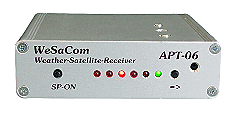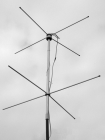APT Weather Satellite Reception - Hardware
The Receiver
To receive APT transmissions from the NOAA weather satellites, you require a receiver. The satellites transmit their datastream in the 137 MHz band using frequency modulation (FM). Although you can listen to their 'tick-tock' signature using a fairly inexpensive scanner and whip antenna such a system will not enable the reception of good images.
The reason for this apparent anomaly is due to the bandwidth of the signal. Most scanning receivers have available FM bandwidths of either 150kHz, for FM broadcasts, or about 5kHz for amateur or mobile service transmissions. Weather satellite signals require a bandwidth of 40kHz - 50kHz to accommodate the signal itself plus the Doppler effect. The Doppler effect is identical with the familiar change in pitch of a police car siren as it approaches then recedes from you - initially high pitched, becoming lower as the satellite firstly approaches the listener, flies overhead, then recedes again, this variation is added or subtracted to the signal thus widening its bandwidth.
Therefore a specialised receiver is necessary.
Options
Note: This (& the R2FX) are no longer available from the GEO Shop and no more are being made. A new receiver, the R2FU is now available.
Alternatives found on the web
 |
The Kosmek receiver is part of a complete APT receiving system designed by the VFS (Vision From Space) group in the Ukraine. It can be operated stand-alone or by computer control by serial port link. More |
|
Wrasse WeSaCom APT-06 Weather Satellite Receiver.
Now available with antenna diversity. |
 |
The Antenna
The signals from the NOAA weather satellites are transmitted with right-hand circular polarisation. There are two common solutions to this problem, the crossed dipole (or turnstile) and the quadrifilar helix (QFH) antenna (in each case, designed and tuned specifically for the 137 MHz band).
 Crossed Dipoles |
 QFH |
The antenna should be positioned with a clear aspect to all horizons. If roof-mounted, make certain that no metal objects are likely to come between it and the satellites. Ideally, it should be the topmost structure on any antenna mast. If you cannot roof-mount your antenna, good results are still possible so long as there are no obstructions nearby. Good results have been reported with the antenna secured to a post just a metre above ground level.
Note also that buildings, trees and heavy foliage coming between the satellite and the antenna will all degrade the signal you receive.
Masthead Preamplifier
Generally, the receiver and antenna combinations listed above should produce more than adequate signal strength to create perfect images from the NOAA APT data stream, and should not require a mast-head preamplifier. Preamplifier designs specifically for weather satellite reception are available from specialist suppliers, but are best omitted from your station unless you are experiencing severe signal attenuation due to local reception problems, or have an exceptionally long run of antenna co-axial cable leading to the recieiver (over 20 metres). Be aware that, if your problem emanates from interference to the satellite signal, a preamplifier will simply amplify this also, and you will be no better off.
Decoding the Signal Using a PC with Soundcard
The most popular means of decoding weather satellite transmissions and creating images these days is accomplished by means of a personal computer and a soundcard. The soundcard is the a/d demodulating interface, while appropriate image display software on the PC is used to view the images. For more details, refer to the 'Image Processing' page.

